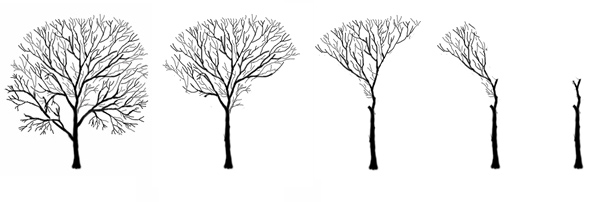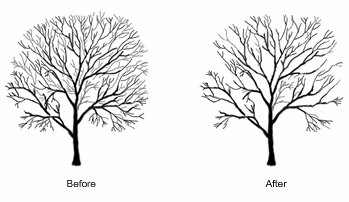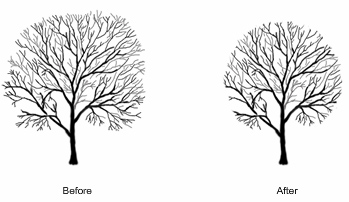Tree Surgery
Caledonian Tree Services
Tree Surgery
Tree Surgery
Tree surgery or Arboricultural works is an umbrella term for any work carried out on a tree other than felling / removing it. The British Standard (BS:3998 Tree Work Recommendations) sets out the best practice for carrying out all tree works. These recommendations take into account that trees are living organisms and the balance that needs to be struck between keeping a tree healthy & thriving and the wishes / expectations of the client
Sectional Dismantiling
Complete sectional dismantling is the process used to remove trees where felling is not possible due to either poor access or where the tree is located within a confined area. i.e. a tree in an enclosed garden.
The process involves the removal of the branches that make up the crown of the tree. These are then lowered to the ground using ropes to prevent any unnessasary disturbance of the surrounding grounds. Once the crown has been removed the remaining trunk is then cut into sections from top to bottom & again lowered to the ground.

Crown Lifting
Crown lifting is the removal of individual branches at the lower part of a trees crown. In doing so the distance between the base of the canopy & ground level is increased.
There are a number of reasons to carry out crown lifitng. In domestic areas it will allow more light into the garden and can also be done to remove any obstructive or obtrusive branches. It is also a good means of opening up a desirable view.

Crown Thinning
o ensure the health of your tree all works will be carried out in accordance with BS:3998 Tree Work Recommendations.
Crown thinning is the removal of a portion of smaller/tertiary branches, usually at the outer crown, to produce a uniform density of foliage around an evenly spaced branch structure. It is usually confined to broad-leaved species. Crown thinning does not alter the overall size or shape of the tree. Material should be removed systematically throughout the tree, should not exceed the stated percentage and not more than 30% overall.
Common reasons for crown thinning are to allow more light to pass through the tree, reduce wind resistance, reduce weight (but this does not necessarily reduce leverage on the structure) and is rarely a once-only operation particularly on species that are known to produce large amounts of epicormic growth. (Note: Information from Arboricultural Association).

Crown Reduction
To ensure the health of your tree all works will be carried out in accordance with BS:3998 Tree Work Recommendations.
Crown Reduction involves the reduction in height and/or spread of the crown (the foliage bearing portions) of a tree. Crown reduction may be used to reduce mechanical stress on individual branches or the whole tree, make the tree more suited to its immediate environment or to reduce the effects of shading and light loss, etc. The final result should retain the main framework of the crown, and so a significant proportion of the leaf bearing structure, and leave a similar, although smaller outline, and not necessarily achieve symmetry for its own sake.
Crown reduction cuts should be as small as possible and in general not exceed 100mm diameter unless there is an overriding need to do so. Reductions should be specified by actual measurements, where possible, and reflect the finished result, but may also refer to lengths of parts to be removed to aid clarity, e.g. ‘crown reduce in height by 2.0m and lateral spread by 1.0m, all round, to finished crown dimensions of 18m in height by 11m in spread (all measurements approximate.)’. Not all species are suitable for this treatment and crown reduction should not be confused with ‘topping’, an indiscriminate and harmful treatment. (Note: Information from Arboricultural Association).

Tree Felling / Removal
Tree felling is the complete removal of a tree from the site. Where space allows the tree will be felled in a single section. By using specialised techniques we are able to control the direction in which the tree is felled. The felled tree will then be cut into sections, all smaller diameter timber chipped, and larger timber cut to manageable size and removed from site.
Trees in small enclosed spaces or near buildings or other structures will nedd to be Sectional Felled. A skilled, qualified tree climber will access the tree using a Rope and Harness. They will cut smaller parts from the tree and lower them to the ground using ropes. They will work their way down until the whole tree is removed.
Deadwood Removal
To ensure the health of your tree all works will be carried out in accordance with BS:3998 Tree Work Recommendations.
Deadwooding involves the removal of Non-living branches or stems due to natural ageing or external influences. Deadwood provides essential habitats and its management should aim to leave as much as possible, shortening or removing only those that pose a risk. Durability and retention of deadwood will vary by tree species. (Note: Information from Arboricultural Association).
Pollarding
To ensure the health of your tree all works will be carried out in accordance with BS:3998 Tree Work Recommendations.
The initial removal of the top of a young tree at a prescribed height to encourage multistem branching from that point, traditionally for fodder, firewood or poles. Once started, it should be repeated on a cyclical basis always retaining the initial pollard point. Pollarding is a management practice that is started when a tree is young. (Note: Information from Arboricultural Association).
Pollarding is different to ‘topping’ a mature tree. For some tree species, taking the top of an established tree may introduce disease or sent the tree into shock. A good knowledgeable Arboriculturalist will be able to outline what options are available for your tree while reducing the risk of casing it damage or premature death.
Coppicing
The cutting down of a tree within 300mm (12in) of the ground at regular intervals, traditionally applied to certain species such as Hazel and Sweet Chestnut to provide stakes etc.




